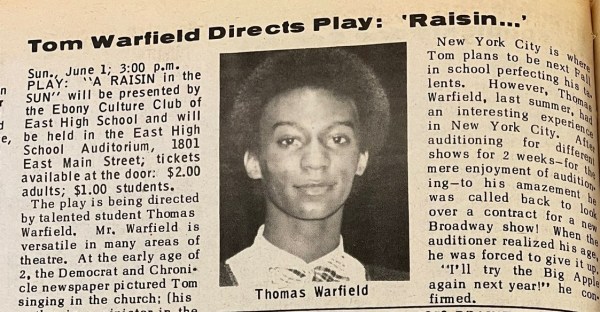Among the most valuable historical resources I used while researching my book were the various Black newspapers published in Rochester. In the 19th century, Frederick Douglass used the North Star to give a far fuller account of the school desegregation movement than the mainstream white newspapers of the period. Howard Coles, the great Black newspaperman of the 20th century and a dedicated Douglass disciple, wrote essential first-hand accounts of deteriorating housing conditions in Rochester at the beginning of the Great Migration that were not replicated by the Gannett newspapers until many years after. And in the 1970s and ’80s, James and Carolyne Blount’s about…time magazine had great in-depth profiles and features of Black community leaders.
Unfortunately, it was not until after my book was published that I learned about another long-running Black newspaper. It was called Communicade (rhymes with lemonade) and was published every other week from 1972 to 1986.
For almost that entire time, the editors were Mary Jane Walker and Frank Willis. Walker had a long career in local media, including at WXXI and WCMF. She talks about her life and Communicade in this 1980 oral history interview. Willis, meanwhile, is best known for spending 20 years on the Rochester school board, from 1980 to 1999. Both are still alive and living in Rochester.

I first saw a reference to Communicade while searching for information about Willis and his time on the school board. I initially found only scant information about the newspaper online, and no way to read it. After a bit of asking around, though, I learned the Rochester Public Library Local History Division has the entire 14-year run in three large bound volumes; they’d somehow been misclassified and weren’t listed in the library catalog.
A few weeks ago, I took a few days to look through every issue. I was extremely impressed with the breadth of coverage, both news and editorial, on local affairs, especially in the first several years. The music coverage in particular was excellent, with interviews and concert reviews from the incredible R&B, soul, jazz and blues performers who came through town on a regular basis. Communicade regularly stories about Attica Correctional Facility as well as letters to the editor from inmates. A regular feature called “Personality Spotlight” highlighted community leaders. Incidents of police violence got comprehensive coverage, as did Black candidates for elected office.


Willis in the early 1970s worked as a relocation case worker for urban renewal projects, and so there were early features on urban renewal and the Model Cities project in northeast Rochester. Later there were multi-part stories on Black nationalism in Rochester and the singer William Warfield, among other topics. Communicade regularly stood up for people who believed they’d been the victim of racial discrimination, whether at the hands of police, landlords, employers, doctors or someone else.
Another treat in reading those old newspapers was recognizing familiar names. Rev. Lawrance Evans, father of Mayor Malik Evans, had a regular column. One issue featured a striking cover portrait of Garth Fagan. Longtime City Councilwoman Loretta Scott and artist Thomas Warfield were both featured as high school students — Scott as a cheerleader at Madison High School, Warfield for directing a performance of “A Raisin in the Sun” while still a student at East High School.



Unfortunately, Communicade had something in common with the North Star and the Voice besides quality journalism — a persistent need for financial help. Just a few years after it launched, Walker and Willis began writing semi-regular editorials beseeching Rochesterians, especially Black people, to support the enterprise.
By the 1980s, the pool of staff writers and skilled freelancers had dwindled and Communicade began to rely more on nationally syndicated material. They still managed to produce some excellent pieces, however; one of my favorites was a long profile of a local jazz trombonist who went by the name Jamaica Jive. One of the last local news stories had to do with the unveiling of an Austin Steward bust in February 1986.

As it turned out, Communicade coincided with the early years of about…time, James and Carolyne Blount’s magazine, which started in 1970. From what I’ve read, about…time had a more culturally conservative perspective, while Communicade, in particular in the early years, identified strongly with Black nationalism and tended to address racism more directly. Still, both were seeking support from the same pool of people. Rochester likely could have easily supported one high quality Black news publication during that pre-internet time, but there ultimately was not enough demand for two.
It is nonetheless significant that Communicade managed to last 14 years and to produce some extremely valuable journalism. I learned about it too late to use it for my book research but look forward to spending more time with the back issues in the future.

